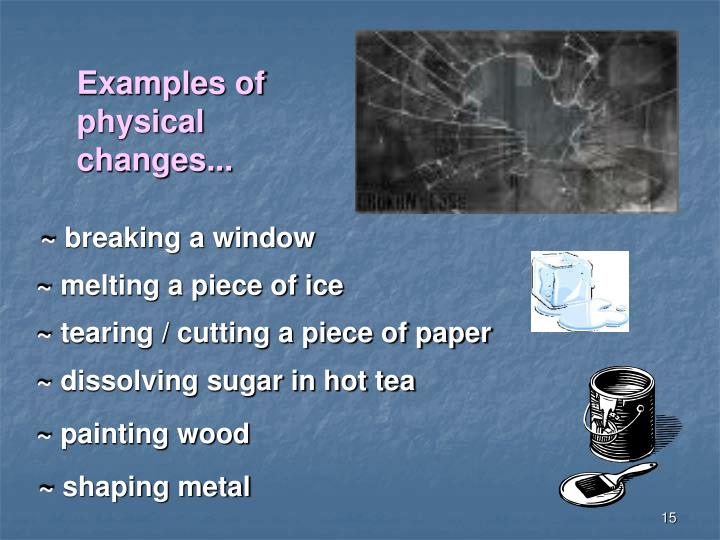

Dissolve a tablespoon of sugar in a glass of water.When a metal such as gold is melted, it goes from a solid to a liquid.When the clouds collide and it rains, the water goes from a gaseous state to a liquid.When a piece of cheese is grated with a grater.When glass comes into contact with high temperatures, it becomes more malleable.When the ice cream is out of the freezer and thaws.This is as a consequence that the water vapor turns into liquid. When a glass is fogged, after a while droplets begin to form.When you put water to boil in a pot, it goes from a solid to a gaseous state.When the mercury found in a thermometer comes into contact with high temperatures, its size expands, but its nature does not change because of this.When a sheet of paper is torn into several pieces.


And it also has to do with going from a liquid to a solid state. While in the previous case only the surface particles are affected, in this case, it reaches all of them. This phenomenon can also occur at room temperatures. In this case, the substance changes from a liquid to a gaseous state as a consequence of the high temperatures. Have students investigate what happens when the liquid butter is cooled. The change must have been caused by the heat and not just the stirring. Note: Let students know that the butter you stirred without heating didn’t change much at all. When we tilted the cup, the butter flowed. Explain that you want to see if anything happens to the butter from just stirring it, or if it’s the heat that really causes the melting. Note: Tell students that while they heat the butter and stir it, you will stir the same amount of butter in the same type of cup but not heat it. Keep stirring until the butter doesn’t change any more. Keep the cup in the hot water and keep stirring until you see a change in the butter.If the butter gets stuck on the popsicle stick, use the other popsicle stick to push the butter back down into the cup. Use the popsicle stick to move the butter around in the bottom of the cup.Carefully push your plastic cup with the butter a little way into the hot water cup.Small plastic cup with ¼ teaspoon of butter in it.Safetyīe sure students wear properly fitting goggles. The activity sheet will serve as the Evaluate component of the 5-E lesson plan.

Students participate in a class discussion about how heating and cooling can cause changes in matter.ĭownload the Student Activity Sheet (PDF) and distribute one per student when specified in the activity.They also see that cooling butter makes the molecules move more slowly and come back together. Students view an animation showing that heat causes the molecules in butter to move faster and separate from each other.Students warm butter until it melts and then cool it until it turns hard again.Students see a video of water freezing and then melting.NGSS 2-PS1-4: Construct an argument with evidence that some changes caused by heating and cooling can be reversed and some cannot.Cooling a substance makes the molecules move slower.Heating a substance makes the molecules move faster.If ice is warmed enough, it can change to liquid water.If water is cooled enough it can change to ice.The lesson can also be used to lay a foundation for learning about changes in state and chemical changes which can be further developed in later grades. Students will also be able to explain that heating a substance makes its molecules move faster and cooling a substance makes its molecules move slower. Students will be able to explain that this process can also happen to other substances. Students will be able to explain that cooling water can change it to ice and that heating ice can change it back to liquid water.


 0 kommentar(er)
0 kommentar(er)
